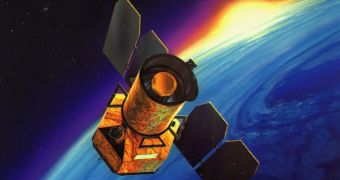Scientists at the NASA Jet Propulsion Laboratory (JPL) in Pasadena, California, announce that they will no longer be attempting to conduct scientific observations using both detectors aboard the Galaxy Evolution Explorer. The telescope, which has been orbiting the planet since 2003 and that exceeded its life expectancy considerably, will continue to survey both the near and distant Universe using its other detector. The secondary observations instrument is still very much operational, even after 7 years of being in Earth's orbit. The GEE explores the skies in ultraviolet wavelengths.
“The remaining, near-ultraviolet detector is still busy probing galaxies both nearby and distant. We've got lots of science data coming down from space,” says JPL GEE mission manager, Kerry Erickson. Over the past years, the telescope has proven to be extremely apt at surveying the Universe, producing maps of several tens of millions of galaxies, some of them no less than 10 billion light-years away. It features two UV-sensitive instruments, one that is best suited for detecting far-UV wavelengths, and the other more finely-tuned to observe near-UV wavelengths.
The far-ultraviolet detector basically shorted out – it experienced an over-current condition – in May 2009, and engineers believe a phenomenon called electron field emission caused the glitch. Since then, this particular instrument has been rendered useless. It observes the Universe in wavelengths between 135 and 180 nanometers, while the near-ultraviolet detector sees wavelengths between 180 and 280 nanometers. The thing is that the two have identical viewing capabilities. This means that both were used on the same light sources in order to gain more information about their targets, but that each individual one can see perfectly without the aid of the other.
Mission managers now plan to use the near-UV detector in combination with datasets (in visible light, for example) obtained by other space- or ground-based telescopes. The experts also add that the vast amount of data the far-UV instrument collected thus far will most likely continue to keep astronomers busy for at least a few decades. Surveys conducted on the data the now-broken detector provided have only begun to scratch the surface of the massive volume of information available, the team adds.

 14 DAY TRIAL //
14 DAY TRIAL //